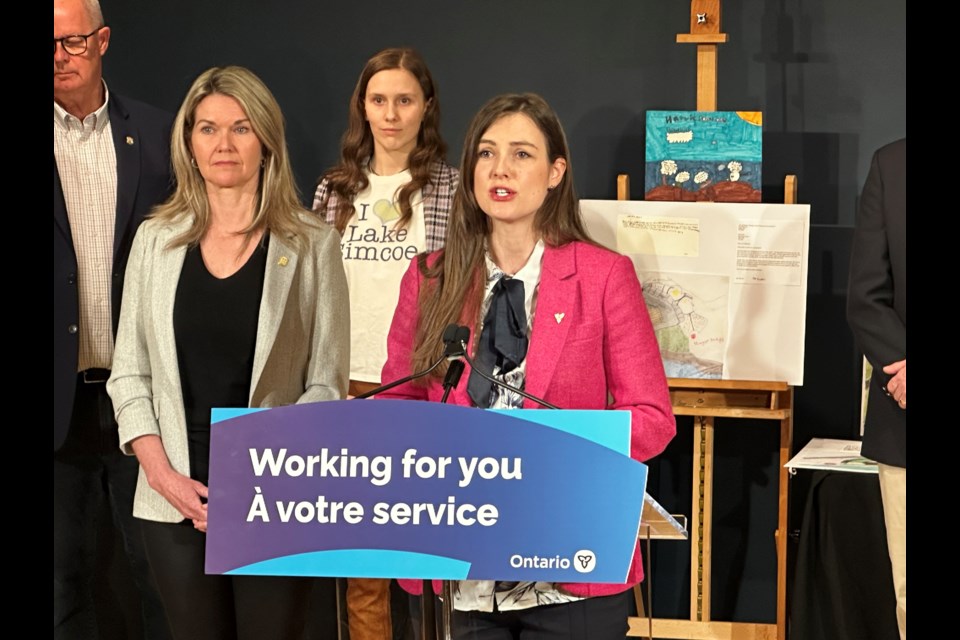Community members and politicians gathered Friday in Orillia to celebrate the $289,000 the province has put toward projects that engage local youth in workshops, field trips, and educational opportunities meant to help restore the Lake Simcoe watershed.
Carried out in partnership with the Orillia Museum of Art and History (OMAH), the funding has provided students from Regent Park Public School in Orillia the opportunity to participate in a variety of projects over the past two school years, with further projects — and potentially other schools — slated for the next academic year.
The event took place at OMAH, with Regent Park students joining Barrie-Innisfil MPP Andrea Khanjin, also the minister of the environment, conservation and parks.
“Over the past three years, our government invested more than $289,000 in three projects to engage local youth and community members in environment stewardship activities to help improve the health of the lake and its communities in the region,” Khanjin said. “These projects have educated students and community members about how they can protect and restore the shoreline and how to reduce the amount of stormwater runoff and pollution going into Lake Simcoe.”
Learning how to design rain and pollinator gardens, among other projects, were the focus of 10 workshops and two field trips meant to educate students and community members on how to protect and restore Lake Simcoe’s shoreline.
“These students have really shown top work for these projects and are a great example for all of us. I’m confident that these students will grow up to be great stewards of Lake Simcoe and for the interior environment,” Khanjin said.
To carry out the projects, OMAH partnered with Parklane Landscapes.
“It was my pleasure to develop a STEAM-based program with Parklane Landscapes, an Orillia-based design and build landscape company specializing in sustainable practices,” said Tanya Cunnington, arts programming coordinator at OMAH.
“Our program promoted the value of youth environmental stewardship in the Lake Simcoe watershed. Through hands-on art projects such as drawing and clay sculpting, we were able to provide the students with an opportunity to learn about native plant species, garden design, ecological protection, stormwater management, habitat restoration and climate resiliency."
Mayor Don McIsaac thanked the province for its efforts to protect Lake Simcoe, and affirmed the city’s commitment to doing its part.
“Our community is very fortunate to be located on the shores of Lake Simcoe, and it’s essential that we all work together to preserve this critical watershed,” he said. “The city is continuously updating and investing in our stormwater infrastructure and stormwater management maintenance and operations guidelines to ensure consistent high-quality stormwater entering Lake Simcoe.”
While the province has provided $37 million to protect Lake Simcoe since 2018 — including $24 million announced through the 2024 budget to reduce phosphorus discharge from the Holland River — local advocates are calling on the government to do more.
“No one is going to hate on kids, flowers and butterflies, but this is the kind of fluff that misleads people into thinking that the government is doing their job in its entirety for Lake Simcoe. They are not,” Claire Malcolmson, executive director of the Rescue Lake Simcoe Coalition, in an emailed statement.
She said new, low-density suburban development “is the most wasteful, farm-eating, environmentally damaging, climate-killing, and expensive way to accommodate population growth,” and criticized the government for axing the Ontario Growth Plan for the Greater Golden Horseshoe.
“Just last week, Ontario got rid of the growth plan. The growth plan is what did the following: constrained urban boundary expansion, required a justification for expanding settlement boundaries, required minimum densities in greenfield and new developments, had a role for the phasing and co-ordination of growth to maximize efficiency and reduce costs,” she said.
“All of those things are in the trash bin thanks to this month’s Bill 185. Frankly, there are not enough flowers and butterflies to compensate for the impacts of sprawl on Lake Simcoe.”



